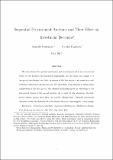Sequential procurement auctions and their effect on investment decisions
Author(s)
Figueroa, Nicolás; Cisternas Leyton, Gonzalo Sebastian
Download5a5f25b5874b3864ca5936f34cc054c7a8b7.pdf (358.9Kb)
OPEN_ACCESS_POLICY
Open Access Policy
Creative Commons Attribution-Noncommercial-Share Alike
Terms of use
Metadata
Show full item recordAbstract
We characterize the optimal mechanism and investment level in an environment where (i) two projects of independent costs are purchased sequentially, (ii) the buyer can commit to a two-period mechanism, and (iii) the winner of the first project can invest in a cost-reducing technology between auctions. We show that, in an attempt to induce more competition in the first period, the optimal mechanism gives an advantage to the first-period winner in the second auction. As a result of this advantage, the first-period winner invests more than the socially efficient level. Optimal advantages, therefore, create two different channels for cost minimization in buyer-supplier relationships.
Date issued
2015-10Department
Sloan School of ManagementJournal
The RAND Journal of Economics
Publisher
Wiley
Citation
Cisternas, Gonzalo, and Nicolás Figueroa. “Sequential Procurement Auctions and Their Effect on Investment Decisions.” The RAND Journal of Economics 46, no. 4 (October 2015): 824–843.
Version: Original manuscript
ISSN
07416261